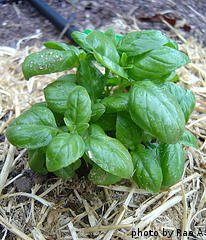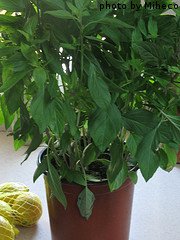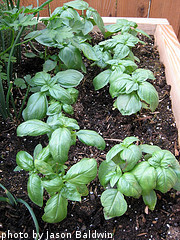Questions About Growing Basil?
You've come to the right place. Some folks love growing basil for the wonderful fragrance that it produces. Others love harvesting the leaves for drying or making pesto or an Italian sauce.

Basil is an herb that is simple to plant, easy to maintain and even easier to harvest. Different varieties of basil produce different basil flavors. Some are stronger tasting and more aromatic than others. Some varieties have a hint of cinnamon, licorice or citrus flavor. Basil can be used fresh to make a variety of sauces or pesto, or as a flavoring in teas. It can easily be dried and used to season almost any variety of meat, poultry, fish or vegetables. Nothing beats the sweet aroma from a fresh basil plant growing in your garden or on a deck or patio.
Basil plants vary in size from 8 inches to 24 inches tall. Growing basil can easily be done in a traditional vegetable garden or in containers. Basil plants need at least 6-8 hours of direct sunlight everyday. They thrive when air temperatures are around 85 degrees F.
Basil is an annual plant, meaning that it will grow for one growing season and then die off. If you want to keep producing basil year after year, you'll have to plant more every year.

Growing basil is very cost effective. A small, 1/2 oz bunch of fresh basil at the grocery store might cost $2-$3. An average sized basil plant might cost $3 to grow, including the cost of seeds, water and fertilizer. Your own basil plant can easily produce 5-8oz of fresh basil, sometimes much more, depending on the variety and growing conditions.
Plan on growing at least one basil plant for each member of your household. This will usually provide enough fresh basil throughout the growing season. If you want additional basil for drying, freezing or making lots of pesto, grow an additional couple of plants. If you have too much, you can always give away the extras to friends and neighbors. Since the plants don't take up much space and are hardy, just about everyone can find a little bit of space to grow a few basil plants if they wish.
Growing basil is a great way to introduce kids to gardening because once they sprout, the plants tend to grow fairly quickly. This gives kids an opportunity to head out to the garden every other day or so to see the new leaves on the basil plants. Basil is also easy to harvest with a pair of safety scissors or you can just let the kids pluck the leaves off with their hands. This way, they get to smell the fresh cut basil and learn about how to care for plants all at the same time.
How you intend to use your basil will determine which varieties to plant. Some varieties are especially tender with a mild flavor. These varieties are best used fresh or in making pesto. Other varieties have a slightly tougher texture and more pronounced taste and aroma. They can be used for drying and seasoning a wide variety of food or making potpourri. Basil and tomatoes are an excellent flavor combination and basil is a key ingredient in most Italian tomato sauce recipes. Basil can also be used in a wide variety of other recipes, both sweet and savory. In addition, we personally love the combination of basil and berries (especially strawberries, raspberries and blackberries) and it also pairs very well with watermelon.
In the summer, we like to muddle (crush) basil leaves and add them to a pitcher of strawberry lemonade. We let the basil steep in the lemonade overnight. The next day, we strain out the basil and have an extra refreshing beverage that can easily be turned into a cocktail with the addition of a little bit of vodka. We also sometimes steep crushed basil in homemade ice cream or sorbet base before freezing it. If you haven't ever tried homemade basil and blackberry ice cream, we highly recommend it!
Quick Overview of Growing Basil
Planting: Plant seeds 1/4 inch deep every 6 inches in your garden at least 2 weeks after the last expected frost in your area. If you want a head start, sow seeds in flats or cups and then transplant when the seedlings reach 3 inches tall.
Fertilizing and Watering: Use a balanced fertilizer and apply just before planting/transplanting and again 6 weeks later. Keep soil around plants evenly moist but not wet.
Harvesting: Begin picking the top leaves of the plants when they reach 6 inches tall. Continue harvesting a few leaves every few days, giving the plants time to regrow.

Click here to move from our Growing Basil main page to our Planting Basil page
Click here to learn about fertilizing and watering basil plants
Click here for information about harvesting basil
Click here for information about different basil varieties
Click here for some of our favorite basil recipes